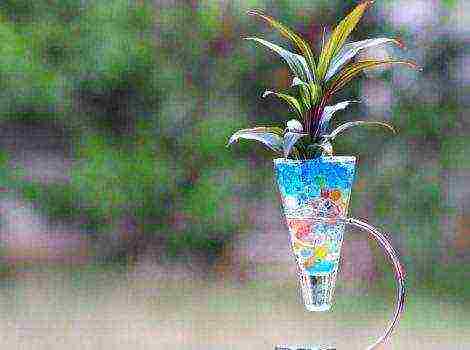Content
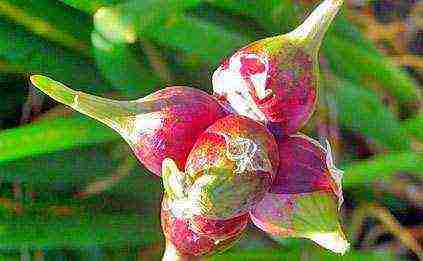
The tiered bow is unique. Scientists believe that its origin is the natural hybridization of onions with a batun or other perennial onions that do not form true bulbs. It got its name for its peculiar appearance in adulthood. Instead of flowers on the flower arrow, it grows small bulbs - bulbs with a diameter of 1.5-2 cm, and then the peduncle continues to grow, and this happens up to 4-5 tiers, more often 2-3.
The height of the peduncle at the first tier is 60-80 cm, 3-5 pcs are formed on it. the largest bulbs. Each next tier has a shorter peduncle and smaller bulbs. To get more large air bulbs, you can limit growth by pinching the growth point of the peduncle after the second or even the first tier.
In the first year of life, multi-tiered onions differ very little from onions. It has the same fisty leaves up to 60 cm high, forms a bulb with a diameter of 3.5 to 7 cm (weighing 45 to 70, in some cases up to 100 g). Unlike onions, these bulbs are false, not ripening, remaining open. In subsequent years, the bulbs become smaller as each of them divides to form a nest.
The highest productivity of a multi-tiered onion is in the 3-4th year of life, later the nest becomes strongly compacted and oppression occurs.
There is no point in planting perennial onions for more than 5 years, they must be planted. For planting, both underground bulbs and bulbs can serve. The offspring of aerial bulbs are preferable, since they are rejuvenated and develop, as from seeds, which a multi-tiered onion does not form.
The multi-tiered onion is a very promising crop - in terms of productivity, it exceeds both onions and batun. He also uses greens, and it is more tender and contains more vitamins, and both underground and aerial bulbs. The latter are often pickled. Multi-tiered onions are very cold-resistant, withstands winter frosts up to 50 ° C. Does not freeze even in winters with little snow. Thaws are dangerous for him.
It can endure the harshest winters and die from early spring frosts - it does not have a dormant period and, when warming, quickly starts to grow. Therefore, it is recommended to plant the bulbs in the fall, mulch them with chopped straw, peat or sawdust to reduce fluctuations in soil temperature.
The multi-tiered bow grows very early - still under the snow, and grows rapidly. In a temperate climate zone, its leaves reach 30 cm already in the first ten days of May and are ready for harvesting - they can be cut off, and after 2-3 weeks the leaves will grow back, and cutting can be repeated. To further accelerate the production of greens, film shelters are used, in this case, the receipt of products is accelerated by 10-12 days. Usually 3-4 cuts are carried out per season.
Multi-tiered onions are cultivated in annual and perennial crops. The southern and southwestern slopes are good for it, areas that are early free from snow, with light fertile soils are preferable. Planting patterns are different: larger underground bulbs are planted in rows with row spacing from 40 to 70 cm, in a row -15-20 cm, large air bulbs in a row 5-8 cm, small ones - more often.
For annual cultivation, a belt planting method is convenient with distances in a row for podzimny bulbs 10-12, for bulbs - 6-8 cm.The planting depth depends on the size of the bulbs - the soil layer from the shoulder of the bulb to the soil surface should be 2-3 cm.
Agrotechnics of a tiered bow are common for bows. In the spring, at the beginning of the regrowth of leaves, top dressing is necessary. They can be organic or mineral. In the future, fertilizing and watering, if necessary, are carried out after each cut. Weeding and loosening are required.
Multi-tiered bows are successfully driven out in greenhouses, in greenhouses, or in a room. It does not have a dormant period and is less demanding on lighting conditions and temperature than onions. In winter, in a room, it can be grown in light boxes or pots on the windowsill. Forcing requires a small amount of land. This onion is tender, very tasty, healthy, especially when there are not enough vitamins.
Until now, even experienced gardeners look with amazement and a fair amount of doubt at the multi-tiered bow. An unusual type of vegetable crop raises concerns that such an "exotic" plant can be successfully grown in the local area. In fact, a multi-tiered onion is unpretentious to care for, frost-resistant, and harmful insects prefer to bypass it. The decorative component is no less important - rarely any of the passers-by remains indifferent at the sight of beds with an amazing plant.
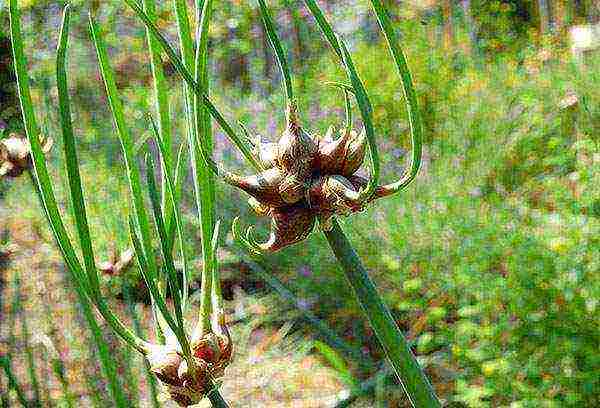
Characteristics
Gardeners appreciate multi-tiered onions for their ease of growing, unpretentious care, juicy crunchy bulbs and, undoubtedly, an unusual appearance.
- Plants located on the first tier form small, airy fruits with green feathers. They become the basis of the second tier and begin to release arrows again. Gradually, an amazing multi-layered vertical bed of onions is formed.
- The bulb under the ground is loose and small. In the process of growing, it breaks down into several parts, but their taste leaves much to be desired. But onions of medium size, located above the surface of the beds, are distinguished by excellent strength, juiciness, sharpness and crunch.
- The dormant period in multi-tiered onions is completely absent, therefore it bears fruit throughout the growing season.
- The root system of a vegetable crop in a couple of years reaches a diameter of 1.5 m, which is not surprising - it needs to provide a huge multi-tiered plant with nutrients.
- Young green arrows do not coarse for a long time compared to conventional onions.
Gardeners grow multi-tiered onions without any problems even in the northern latitudes, and residents of the southern regions provide themselves with fresh herbs and juicy elastic bulbs for several months in a row.

How to prepare for boarding
Multi-tiered onions are unpretentious in care, but they have certain requirements for the soil. The soil for its cultivation must be neutral and fertile, therefore, organic fertilizers are applied to it before planting. If you choose an open, sun-lit area for planting, then you can collect a rich harvest for 4-5 years. In order for the first green feathers to appear in early spring, the plant should be planted in the hills.
Advice
Despite being frost-resistant, multi-tiered bows can suffer from extreme temperature changes. Experienced gardeners cover the beds with dense breathable material during spring frosts.
The plant throws out the first green arrows a year after planting, and a month later begins to grow air bulbs to form the second tier. A vegetable crop grows very quickly, and when it is grown in the southern region, with proper care, the harvest from one garden is quite enough for winter stocks.
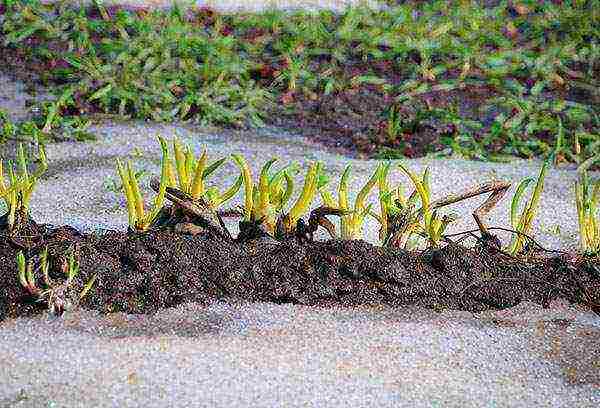
Reproduction and planting
Gardeners rarely propagate bulbous plants by seed. This method is practiced only to replenish its collection with new varieties.
How can a multi-tiered bow be propagated:
- bulbs from the 2nd or 3rd tier;
- dividing the overgrown bush.
It is very important to collect the bulbs before they start to release green arrows.Bulbs collected at the end of summer are suitable for planting. They manage to build up the root system in the fall and prepare for a long harsh winter. After collecting the seed, it must be thoroughly dried, and then placed in the refrigerator in a paper bag.
When landing, you should adhere to a simple algorithm of actions.
- Dig up a garden bed, apply any organic fertilizer.
- Plant the bulbs to a depth of 3.5-4 cm, at a distance of 10-15 cm from each other.
- When planting in a greenhouse, the distance between the bulbs should not exceed 3 cm.
With the onset of spring, you can propagate a multi-tiered onion by dividing the bush. The best time to carry out this type of gardening work is after a heavy rain. In order for the bulbs to begin to build up the root system, you need to leave only the central feathers, and trim the side feathers.
Advice
Experienced gardeners recommend planting the bulbs in a checkerboard pattern to speed up the formation of subsequent tiers during further cultivation.
If the planting of a vegetable crop is carried out in moist soil, it is better to make a high bed to prevent onion decay. It is necessary to add nutrients to the soil: per 1 sq. m a couple of buckets of organic matter, 1 tbsp. a spoonful of potassium salts, 2 tbsp. tablespoons of superphosphate. Care of multi-tiered onions will be easier if river sand is added to heavy clay soil before growing.
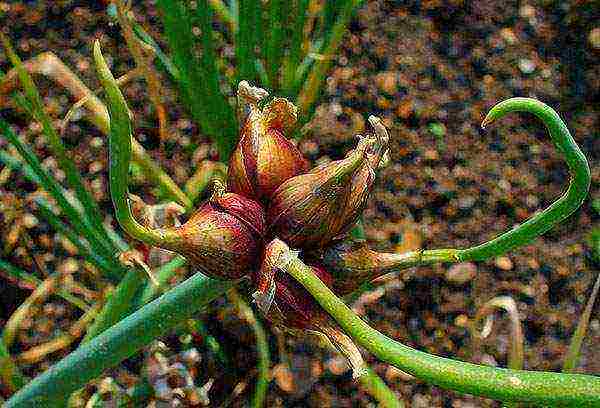
Proper plant care
A multi-tiered onion will regularly bear fruit even with a negligent gardener, and with good care, the harvest will be completely excellent. The soil under the plant should not be too wet, otherwise the tender bulbs will rot. You need to water the garden with onions as the top layer of the soil dries out. The more water is added to the root, the larger the bulbs are when grown, but at the same time they lose their unique bitterness and crunch.
What kind of care does an "exotic" plant need?
- The soil under the onions needs to be loosened weekly - the flow of fresh air is very important for the root system.
- As soon as the first bulbs appear on the green feathers, it is necessary to attach the arrows to wooden pegs to avoid unwanted damage.
- During the summer, you need to feed with any mineral fertilizer diluted in accordance with the instructions.
- With rapid growth in height, the vegetable crop must be thinned out or divided into several parts.
The plant reacts negatively to weeds, so you need to pull them out regularly. In this case, mulching with cut grass will help to facilitate maintenance. Peat, sawdust or spruce needles will acidify the soil unnecessarily, and this will slow down the growth of onions. For successful wintering during autumn planting, the soil must be well loosened in order to destroy the larvae of onion flies.
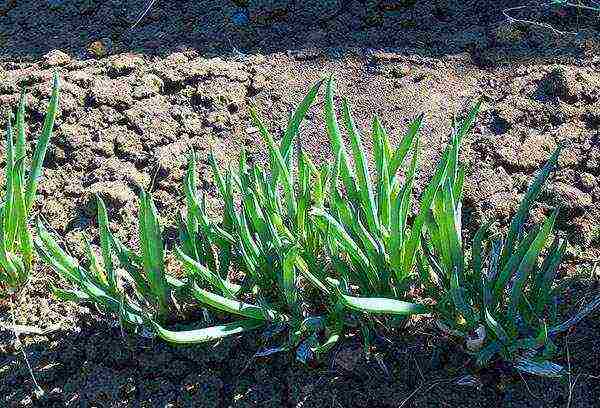
Control of garden pests
The main diseases of the bulb crop that a gardener may encounter when growing are various types of fungal mold. Suddenly, the previously emerald feathers begin to turn yellow and wither. This means that the plant is sick with peronosporosis, it does not have enough nutrients for growth. If you do not urgently take action, then in a few days the fungi will infect all the specimens in the garden. To combat pathogenic fungi, it is necessary to spray three times with a 1% solution of Bordeaux liquid.
Avoiding onion fly and weevil infestations can be done with proper care. This makes growing tiered onions a pleasure. You should only remove accumulated debris and remove dried feathers and leaves. It is in them that harmful insects like to settle.
Many gardeners sow bulbs collected in the fall on the windowsills. With this sprouting method, the tiered bow will quickly knock out the first green arrows. By gradually planting the bulbs, you can provide your family with fresh herbs all winter. But do not wait for the formation of the second tier - this happens only in open ground.
The multi-tiered onion is a perennial with branching leaves and is very frost-resistant. This type of onion can be propagated vegetatively, root way and air bulbs.
The name multi-tiered comes from the aerial bulbs growing in several tiers. It does not grow in its natural environment. Such a bow is also called Egyptian or viviparous. You can see how air bulbs look like in the photo and video.
Egyptian or viviparous tiered bow
And we will try to figure out in more detail what are the advantages of a multi-tiered onion, how it is grown, and what kind of care it needs.
Features of multi-tiered onions and their varieties
The leaves of the onion are tubular, from 1.5 to 2 cm wide, in the first year they can grow 40-50 cm in height, in the following years - 80 cm.
- The roots of the multi-tiered onion are stronger than the roots of the onion and can be up to 1.5 meters in length.
- The bulbs tolerate well even frost at 40 °.
- Airy bulbs are best kept frozen.
- Growing such an onion is beneficial in that it sprouts 10 days faster than a batun onion, and in the autumn period it can be planted immediately after harvest.
In spring and summer, onion feathers are good to eat fresh. The process of coarsening of the leaves of this type of onion occurs later than that of the batun, and in terms of taste it is sharper than onion. The green leaves of the multi-tiered onions are quite firm and juicy, and crunch when cut.
The leaves of the multi-tiered onion have a high phytoncidal activity, therefore, they can be used as an anti-inflammatory agent, for hypertension and diseases of the gastrointestinal tract. For treatment, multi-tiered onions are used both fresh and boiled. And pickled onions of this type are good for scurvy and atherosclerosis.
The multi-tiered onion has a strong and well-developed root system. When you plant it, you will get a good harvest of green leaves suitable for human consumption. Along with the feather, you can get an excellent harvest of bulbs that are underground and above the ground. Both can be used both as seeds and for food.
Multi-tiered onions are very yielding
The bulbs located above the ground have a rather dense structure, they are pungent in taste, and tolerate low temperatures well.
And underground bulbs are loose and tolerate storage extremely negatively, so it is better to find their use right away. They are suitable for various pickles, they are well marinated, and you can use them as planting material.
Currently, the cultivation of such varieties of onions as:
- Odessa winter,
- Likova,
- Gribovsky 38,
- Memory.
Likov's variety is high-yielding and early. But this variety requires additional care, protection from diseases such as thrips. The fresh greens of this tiered onion have a pungent flavor. Open landing is preferable.
Air seeds - bulbs - should be planted to a depth of 3-4 cm, and the distance between the rows should be 15 cm.
Winter variety Odessa in the photo:
Growing multi-tiered onions
Growing multi-tiered onions is possible both outdoors and in greenhouse conditions.
Outdoor cultivation
- Loamy soils are well suited for growing onions. A multi-tiered onion can grow in one bed for about 5 years.
- The second half of August and the beginning of September are considered optimal for planting. Thus, the onion will have time to take root before the cold weather arrives and will endure the winter well, which will give good growth in the spring.
- In the winter, the part of the onion that is above the ground almost completely dies off. But even in this form, the onion winters well.
- The tiered bow is frost-resistant and can withstand temperatures down to -45 ° C, even with little snow cover. But for a successful wintering, as previously mentioned, it is necessary that the onion has time to develop a root system.
- A multi-tiered onion can be harmed by sudden jumps in spring temperatures, when, after a rather long thaw, there is a sharp drop in temperature again.
- On beds with perennial plantings of onions, it is necessary to remove all rotten leaves that may contain pathogenic microflora with the onset of spring.
- Green onion leaves begin to grow almost immediately after the snow melts. Shooting occurs in the second year of the bow's growth. Shooting period - late spring or early summer. Several layers of air bulbs appear on the arrows in July-August. The higher the tier on which the bulbs grow, the smaller they are.
- The multi-tiered onion grows especially well in warm weather, with the right amount of moisture.
- You can eat these green onions before the first air bulbs appear.
- To plant a multi-tiered onion to obtain green leaves, you need to be at a distance of 20 cm from each other, and the distance between the rows should be 25 cm.
Seed material of a multi-tiered onion variety Likova
To obtain seed, the onion is planted in one or two rows at a distance of 10 cm. In the spring it will need to be thinned out, leaving stronger plants at a distance of 20 cm from one another.
It is advisable to calibrate the air bulbs to small, large and medium before planting. It is better to plan the cultivation of the next crop from the planting material collected from the first, second and third tiers. The consumption of the bulbs will be 150 g per 10 m2.
The multi-tiered bow is also called horned because of its arrows, and the formation of air bulbs gave it another name - viviparous.
In addition to bulbs on tiers, multi-tiered onions also have root bulbs, which can also be eaten and used as seed material.
Growing a multi-tiered onion in an apartment.
To do this, in the fall, you need to plant air seeds - bulbs in boxes or pots. They will sprout quickly and provide you with fresh greens. Planting a multi-tiered onion in an apartment will give a good harvest from underground bulbs. But it should be noted that underground bulbs cannot be stored for a long time. It is best to plant them immediately after digging.
Stacked Onion Care and Harvesting
Care for a multi-tiered bow is
- loosening the soil;
- removing weeds from the beds;
- fertilization and regular watering.
The first application of fertilizers should be done during the germination of the leaves, and then after they are cut. Experts advise to make 2 buckets of manure per m2 of area with the addition of superphosphates, potassium salts and ammonia fertilizers.
If the soil is heavy, then you need to add coarse river sand to it. Care such as fertilization can be combined with watering.
The tiered bow is very picky about soil characteristics. For the active growth of this type of onion, fertile and light soil and sufficient watering are needed. It is good to plant onions in the beds where legumes previously grew.
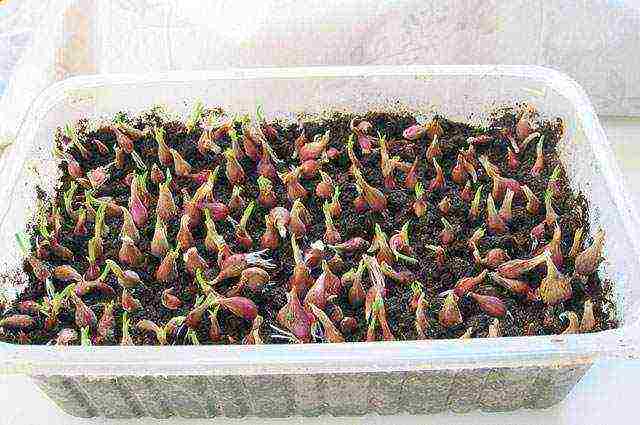
You can grow onions for greens all year round.
The first time you can cut the green leaves after 28-30 days, the second - after another 30. The leaves are cut twice a season. It is undesirable to cut more, this will reduce the yield of air bulbs. If you want to harvest the leaves earlier, you can cover the garden with plastic.
The tall archers of the tiered bow need care. To preserve the air bulbs, it is necessary to tie the arrows to the pegs, otherwise they will break and the seed material will disappear.
Caring for ripe air bulbs is good drying. This can be done outdoors or in a ventilated area. Dry onion bulbs in the photo below.
You need to remove the bulbs from the arrows on time, otherwise they will crumble themselves and take root.
Layered onions are a good planting material for the autumn-winter harvest of green leaves in greenhouse conditions. This type of onion, in contrast to the onion, does not have a dormant period for the bulbs, and therefore grows faster in greenhouse soil.The multi-tiered onions yield the harvest earlier than the batun onions. For a multi-tiered onion, it will be enough to maintain a temperature regime of 15 degrees in the greenhouse, while the onion needs at least 20 degrees of heat. Air bulbs-seeds are planted in the greenhouse by means of a bridge method.
After cutting the green leaves of a multi-tiered onion, it is necessary to loosen the soil each time, feed the planting with ammonia fertilizers and potassium salt and water it well. You may be intimidated by so many chemical dressings per season, but you shouldn't - multi-tiered onions are the only ones that do not absorb nitrates.
The leaves of a multi-tiered onion can be cut when their height reaches 25-30 cm, it is necessary to cut it 5-7 cm higher from the ground level. Usually the interval between two cuts is 20-25 days.
If you planted a multi-layered onion like an annual, then you can make three cuts, and then remove the bulbs before the next planting. If you plan to teach airy bulbous seeds, then the leaves should be spared and not cut off.
It is possible to grow perennial multi-tiered onions, if the necessary conditions are present, almost all year round. This onion does not need special care, and its cultivation will not bring you any trouble. But on your table there will always be tender and juicy greens that are good for your health.
How to properly plant onion sets on greens, you can watch in the video.
Rate the article:
Hello dear readers!
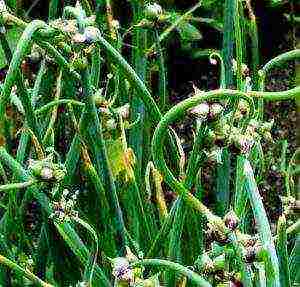 Tiered bow - a perennial plant, differs from an onion - a batuna in the structure of a flower arrow, greater frost resistance (even with a small snow cover, it can winter in open ground at temperatures up to -50 degrees) and a vegetative propagation method. Popularly, a multi-tiered bow has many names - Egyptian, viviparous, horned, Canadian and others. You can cultivate in one place for 5-7 years.
Tiered bow - a perennial plant, differs from an onion - a batuna in the structure of a flower arrow, greater frost resistance (even with a small snow cover, it can winter in open ground at temperatures up to -50 degrees) and a vegetative propagation method. Popularly, a multi-tiered bow has many names - Egyptian, viviparous, horned, Canadian and others. You can cultivate in one place for 5-7 years.
Multi-tiered onions in the first year of cultivation resemble onions. The feathers are large, up to 40 cm long, rather thick, covered with a heavily waxy coating. The nutritional value of this type of onion is higher than other garden varieties. Young juicy leaves of a multi-tiered onion do not coarse for a long time, are more pungent in taste than that of onions. They retain good taste until the first tier of air bulbs ripens. The bulbs are eaten in their usual form, but they are not stored for a long time, since, having a very short dormant period, they quickly germinate. Bubbles may well be used as a seasoning for marinades. If dried well, they can be stored in a dry, unheated room throughout the winter.
If the planting of multi-tiered onions is left for the second year, then the plants form flower shoots up to 80 cm high, on which there are up to four tiers of air bulbs weighing up to 8 grams. The largest bulbs grow on the first tier.
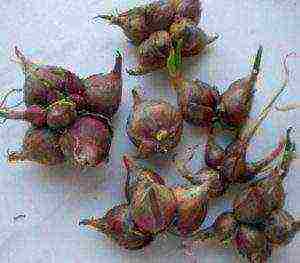 Once you have planted a multi-tiered bow in your garden, you can be sure that you will be provided with sufficient planting material. This is due to the fact that the bulbs themselves form up to four daughter bulbs during the growing season. In addition, the arrows of a multi-tiered onion form not flowers in the inflorescences, but bulbs, which are identical in structure to a regular bulb and are ready-made planting material. And that is not all. As soon as the bulbs at the end of the arrow grow up, the arrow continues its growth upward from the center of the inflorescence, and another tier of bulbs grows at the end. There can be up to four tiers in total.
Once you have planted a multi-tiered bow in your garden, you can be sure that you will be provided with sufficient planting material. This is due to the fact that the bulbs themselves form up to four daughter bulbs during the growing season. In addition, the arrows of a multi-tiered onion form not flowers in the inflorescences, but bulbs, which are identical in structure to a regular bulb and are ready-made planting material. And that is not all. As soon as the bulbs at the end of the arrow grow up, the arrow continues its growth upward from the center of the inflorescence, and another tier of bulbs grows at the end. There can be up to four tiers in total.
Preferred for growing multi-tiered onions light soil, with good moisture and air permeability. Loamy soils, without preliminary preparation, are unsuitable for growing multi-tiered onions. It is very important to fill the soil well with fertilizers before planting the tiered onions. Recommended for 1 sq. m. add 2 buckets of humus, 50-60 grams of complex mineral fertilizer and two liter cans of wood ash.
The best time for planting multi-tiered onions with air bulbs is August-September. The bulbs have time to take root well and in the spring, in very early periods, give a high yield of juicy greens. Despite the small size of the bulbs, the planting depth is at least 4 cm, with a distance in a row of 12-15 cm and between rows of 20-25 cm. In the process of growing multi-tiered onions, feeding with weak solutions of mineral fertilizers is required every time after cutting. In total, cutting per season with good feeding can be done up to four times. Other types of onions cannot boast of such a yield, as well as early maturity.
It is very important that the cut is carried out at a height of at least 5 cm above the neck of the bulb. If after the formation of the first or second tier of bulbs, pinch the arrow, then the quality of the bulbs will become higher.
Depending on what kind of crop the emphasis is placed on when growing multi-tiered onions - on bulbs or arrows, the period for growing onions in one place varies. If the goal is to get exactly the bulbs and arrows, then the bulbs can be left in one place without digging or replanting for up to seven years.
A multi-tiered bow is irreplaceable as a planting material for forcing greens on the windowsill in winter. To do this, you need to plant air bulbs or basal bulbs in sowing boxes to a depth of 2 cm. And without any special worries, you can get a bountiful friendly harvest of green onions.
Best regards, Sergey Mozgovykh
I hope you have read this article with interest, and it turned out to be useful. Perhaps the materials presented in the article, you think are controversial, and you disagree with something, then share your opinion in the comments. If the topic touched upon is of interest to you and you share the author's point of view, share these materials with your friends on social networks using the buttons under the article. And also the blog provides a free subscription form so that you can be the first to receive new articles about growing onions to your email address:

